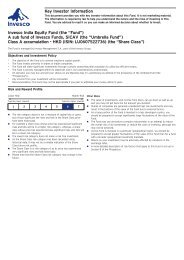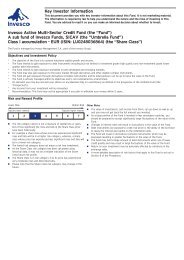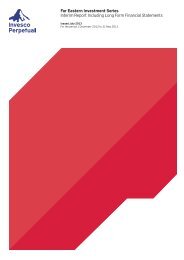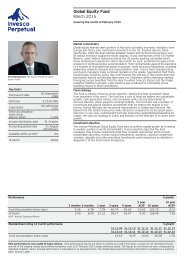Annual report: Period Ended 31 December 2012 - Invesco Perpetual
Annual report: Period Ended 31 December 2012 - Invesco Perpetual
Annual report: Period Ended 31 December 2012 - Invesco Perpetual
Create successful ePaper yourself
Turn your PDF publications into a flip-book with our unique Google optimized e-Paper software.
City Merchants High Yield Trust Limited 23<br />
diplomatic events, tax laws and environmental laws and by changing investor demand. The Manager<br />
strives to maximise the return from the investments held but these investments are influenced by<br />
market conditions and the Board acknowledges the effects of external influences on portfolio<br />
performance.<br />
Investment Risk<br />
The investment style employed by the Manager is set out under Investment Policy and Risk on<br />
page 20.<br />
Portfolio performance is substantially dependent on the performance of fixed-interest and<br />
high-yielding stocks in the UK and elsewhere in the Company’s investment universe. These stocks<br />
are particularly influenced by prevailing interest rates, government monetary policy and by demand<br />
for income.<br />
Risk management is an integral part of the investment management process. The Manager controls<br />
risk by ensuring that the Company’s portfolio is appropriately diversified and by in-depth and<br />
continual analysis of the fundamentals of all holdings, which give the Manager a full understanding<br />
of the financial risks associated with any particular stock.<br />
The performance of the Manager is carefully monitored by the Board and the continuation of the<br />
Manager’s mandate is reviewed each year. More details on the assessment of the Manager are<br />
provided for on page 33. The Board and the Manager maintain an active dialogue with the aim of<br />
ensuring that the market rating of the Company’s shares reflects the underlying NAV and buy back<br />
and issuance facilities help the management of this process.<br />
For a fuller discussion of the economic and market conditions facing the Company and the current<br />
and future performance of the portfolio of the Company, see both the Chairman’s Statement and<br />
Manager’s Investment Report.<br />
High-Yield Fixed-Interest Securities<br />
High-yield fixed-interest securities are subject to credit, interest rate, liquidity and duration risks.<br />
Adverse changes in the financial position of an issuer or in general economic conditions may impair<br />
the ability of the issuer to make payments of principal and interest or may cause the liquidation or<br />
insolvency of an issuer.<br />
The majority of the Company’s portfolio consists of non-investment grade securities. To the extent<br />
that the Company invests in non-investment-grade securities, the Company may realise a higher<br />
current yield than the yield offered by investment-grade securities. On the other hand, investments in<br />
such securities involve a greater volatility of price and a greater risk of default by the issuers of such<br />
securities, with consequent loss of interest payments and principal. Non-investment grade securities<br />
are likely to have greater uncertainties of risk exposure to adverse conditions and will be speculative<br />
with respect to an issuer’s capacity to meet interest payments and repay principal in accordance with<br />
its obligations. A lack of liquidity in non-investment grade securities may make it difficult to<br />
rebalance the Company’s investment portfolio as and when the portfolio managers believe it would<br />
be advantageous to do so. To mitigate these risks, the portfolio managers actively monitor both the<br />
ratings and liquidity of the fixed-interest securities taking into account the Company’s financing<br />
requirements.<br />
Further details of the risk management policies and procedures as they relate to the financial assets<br />
and liabilities of the Company are explained in note 18 to the financial statements.<br />
Foreign Exchange Risk<br />
The movement of exchange rates may have unfavourable or favourable impact on returns as the<br />
majority of the assets are non-sterling denominated. This risk can be mitigated by the use of hedging<br />
and by the use of non-sterling denominated borrowing. The foreign currency exposure of the<br />
Company is monitored by the Manager on a daily basis and reviewed at Board meeings.

















